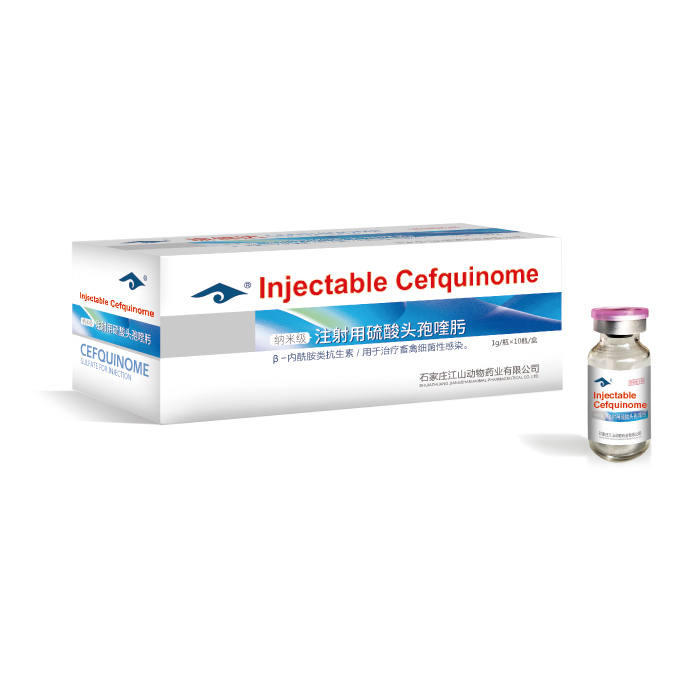
Injectable Cefquinome
Product Overview:
Cefquinoxime sulfate is a special cephalosporin antibiotic for the fourth generation of animals. It has broader antimicrobial spectrum, stronger antimicrobial activity, high stability to beta-lactamase, longer plasma half-life, no renal toxicity and many other advantages. It has been widely used in veterinary clinic.
Product characteristics:
1. Advanced technology, good solubility and quick effect. This product uses advanced wettable powder technology, so that cefquinoxime sulfate can be well dissolved in water, inactivated vaccine or freeze-dried vaccine, and can play a role in an hour after use, with no drug resistance and little side effects.
2. The drug has high activity and affinity. Cefquinoxime sulfate is a fourth-generation cephalosporin product with high drug activity. It can penetrate the outer membrane of Gram-negative bacteria quickly. It is stable to beta-lactamase and has high affinity with penicillin-binding protein (PBP). Its antimicrobial activity is more than five times higher than that of third-generation cephalosporins.
3. Nano-drug with high bioavailability. This product is processed by special technology. The granularity of the drug is very fine up to nanometer level, the dosage is small, the body is easy to absorb, the bioavailability is high, and the clinical effect is obvious.
4. Use with vaccine, 1 + 1 > 2. This product can be mixed with inactivated vaccine and live virus vaccine, which can enhance the immune effect of the vaccine and prevent the occurrence of bacterial diseases.
Target animal safety test:
10-days-old chickens were injected intramuscularly with 1, 3 and 5 times dosage of this product once a day for 5 consecutive days. The changes of clinical symptoms of each group were observed and recorded daily. The blood biochemical indexes were measured 5 days and 7 days after the treatment, and compared with those before the treatment. The results showed that there was no significant change in the blood biochemical indexes of all groups, and there was no correlation with the dosage of Kangjianda. Therefore, Kangjianda was safe in treating poultry bacterial diseases and had no obvious toxic and side effects.
Clinical pharmacodynamic experiments:
In order to verify the clinical efficacy of Kangjianda, 1500 chickens with naturally occurring E. coli and Salmonella were selected in the experiment (judged by the results of autopsy and clinical observation). Clinical symptoms of diseased poultry include diarrhea, green, yellow or white droppings, sometimes mixed with a small amount of blood, fear of light tears, cough and asthma, nasal or oral mucus flow, mouth opening breathing, neck closure, depression, confused feathers, peritonitis, balloon inflammation, arthritis, pericarditis, etc. Kangjianda (cefquinoxime sulfate) and the third generation cefotaxime sodium (cefotaxime sulfate) were used for treatment respectively. The clinical results were as follows:
Clinical effect of treatment of chicken E.coli and Salmonella disease
Infection type | experimental group | case | Use time | Number of cures | Number of Improvement | Effective rate(%) | Cure rate(%) |
Escherichia coli | KJD group | 200 | 3 | 178 | 13 | 95.5 | 89 |
Control group | 180 | 3 | 138 | 16 | 85 | 76 | |
Salmonella | KJD group | 300 | 3 | 285 | 10 | 98 | 95 |
Control group | 280 | 3 | 233 | 21 | 90.7 | 83 | |
Staphylococcus aureus | KJD group | 250 | 3 | 231 | 15 | 92.4 | |
Control group | 250 | 3 | 206 | 16 | 88.8 | 82.4 |
Clinical trials showed that Kangjianda had a remarkable effect in the treatment of poultry bacterial infections (E. coli, Salmonella, Staphylococcus aureus) and was superior to the third generation of cephalosporins.
Functions and uses:
It is used to treat bacterial infections of livestock and poultry (Staphylococcus aureus, Escherichia coli, Streptococcus, Salmonella). It can also be used for respiratory diseases caused by Pasteurella multocida or Actinobacillus pleuropneumoniae.
Usage and dosage:
Subcutaneous or intramuscular injection: one dose, body weight per 1kg, poultry 2.5-5mg, pig 3-5mg. Once a day for 3 to 5 days. It can be used in conjunction with vaccines.
Immunization and medication regimens:
2 days age: Neck subcutaneous injection, 5000 chickens/bottle
14 days age: Neck subcutaneous injection, 500-1000 chickens/bottle
The body weight of each 1kg, poultry 2.5-5mg and pig 3-5mg were treated separately. Once a day for 3 to 5 days.
center